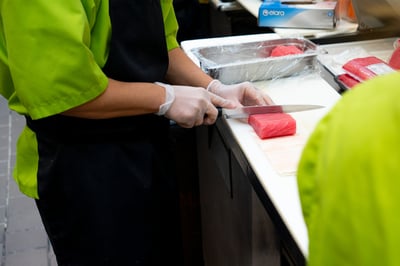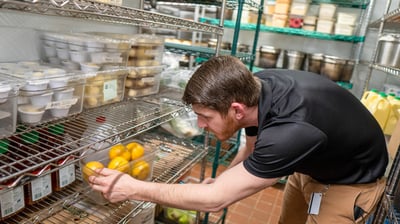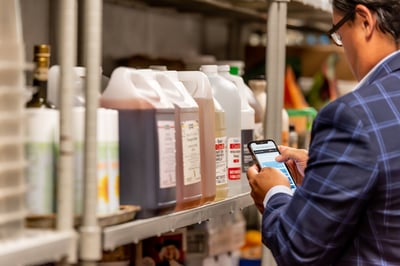The only restaurant inventory management hack you’ll ever need
Operators know that one of the biggest keys to profitability in a restaurant is lowering your food costs. Thankfully, there are a number of ways to do that ranging from simplifying your menu to negotiating with suppliers because you need to knock a couple bucks off the price of prosciutt’ this week thanks to inflation, marone.
What if we told you that one of the best ways to tackle rising food costs is something you can do right now in your kitchen and it only takes 5-10 minutes?
If you’re already taking weekly inventories, this hack probably won’t be super helpful for you. But for operators who are short on time or resources and still want to make an impact in between monthly (or longer) counts, here’s our hack: do a quick count of just your top five highest cost key items before you make an order.
With this restaurant inventory management hack, you can see the benefits of tracking inventory by sustainably manage waste to maximize profitability and wrangle wiley food costs. Here’s how to do it in three easy steps.
How to hack tackling restaurant inventories :
Step one
Take note of your top five highest cost products
If you’re tracking your COGS either with a restaurant management system (RMS) or on another type of spreadsheet, it should be relatively easy to determine your top five highest cost items. If you’re starting from scratch, we recommend looking at your proteins and going from there.

*Note: the author is a millennial, so she’s allowed to sarcastically joke about her generations’ contributions to society.
While rice is definitely going to top the most purchased list at a sushi joint, its pricing is relatively stable (and lower compared to proteins), so you’re probably safe to skip it for this hack. Sticking to perishables will also help save time with this, because you’ll most likely find them all in the walk-in or fridges.
If you don’t already have a spreadsheet or RMS to tell you these items, one way to figure out what to track would be to write down order quantities for your proteins and their prices for a week or two, as long as it’s a typical week, and see what tops the list. Use your most recent invoices for up-to-date product prices.
Step two
Count those five products’ on-hand amounts when you do an order
This is the part that takes a few minutes to do each week. Each time you put in an order for those five products, use your notes app on your phone, a clipboard, or an old expo ticket (if you don’t have ticket printer PTSD) and take a quick on-hand count. If your products are all perishables, then good news- you probably only have one place to go. The bad news is that it might get a little chilly so bundle up!
The benefit of doing this before you put in an order is that you pretty much eliminate the possibility of over or under ordering on those items, preventing your food cost from increasing since both mistakes can add up.
If you know your weekly or daily pars for those items already, then it's a simple pars minus on-hand amount equation to figure out order amounts.

While setting pars versus using gut instinct to order has its benefits- like distributing duties and not being the only person able to do an order every single time - we realize that not every restaurant will have set pars for specific items. Pars are typically dynamic and can change drastically depending on if a holiday is coming up or how many covers are on the books- even good or bad weather can make an impact!
Doing a quick count for your five key items right before you order still gives you a chance to dial in that gut instinct and make better ordering decisions. Bonus points if you track your orders and counts so you can get some of that “distribution of duties” we just talked about.
If you have an RMS, pars can be set automatically for you based on historical sales data from your POS. And speaking of an RMS…
Step three
Get an RMS to help you track even more
If manually updating a spreadsheet with your counts and orders sounds like a pain, then it might be worthwhile to look into bringing onboard an RMS that can do it for you. Not sure what to look for? This blog can help!
The right RMS can also help with inventories by allowing you to set up custom count sheets pre-populated with products from your invoices in whatever order or sections you want. For anyone that’s had to run back and forth across a kitchen trying to take counts from an alphabetical count sheet, you’ll know that being able to customize your count sheets by shelf order is incredibly more efficient.
 If your RMS does automated supplier invoice processing (and it should), it will also be able to show you your five key items to track for this hack along with their most recent prices. This gives you a fuller picture of what over or under ordering can cost your restaurant without spending hours manually entering prices and order amounts into a spreadsheet each week. Best part is, the numbers are automatically updated for you from your invoices and POS data.
If your RMS does automated supplier invoice processing (and it should), it will also be able to show you your five key items to track for this hack along with their most recent prices. This gives you a fuller picture of what over or under ordering can cost your restaurant without spending hours manually entering prices and order amounts into a spreadsheet each week. Best part is, the numbers are automatically updated for you from your invoices and POS data.
So sure, you could absolutely do it yourself with a few hours a week and a spreadsheet, but is that really the best way to spend your time?
The final way an RMS can help make this food inventory hack even easier is by choosing a solution that allows you to take mobile inventories from your phone or tablet directly into the platform.
Some people love taking inventory on a clipboard, and that’s cool- we’re not here to judge. You and your clipboard have been through a lot together and that trauma bond is strong, we understand! But for a society with deep smartphone dependencies, being able to whip that bad boy out of your pocket and smash a quick count just makes sense. It’s 2022 after all - ain’t nobody got time for a clipboard and who the hell wants to pay for all that printer paper?!
Tl;dr
While clearly beneficial, no one works in a restaurant so they can do inventories all day - we get it. So whether it’s by hand or with an RSM, tracking your five key item counts with this quick hack can help make an impact on your margins where they mean the most.


![[Download Now]: Recipe Costing Calculator](https://no-cache.hubspot.com/cta/default/6423873/2e80412b-ff7f-426c-ab1f-bcb566f085c8.png)
